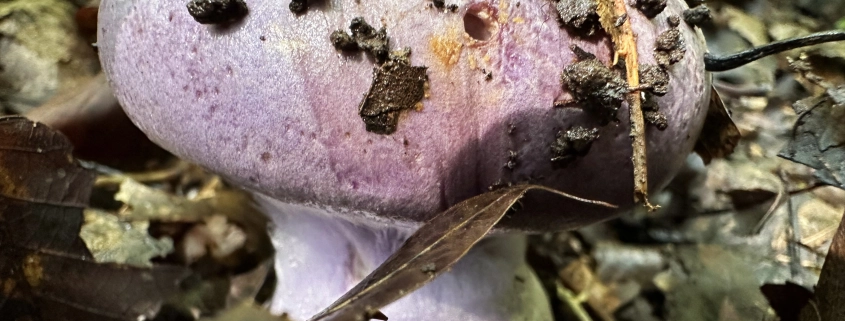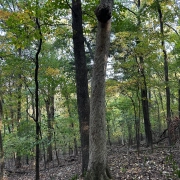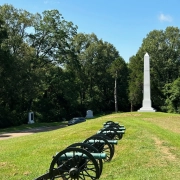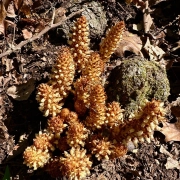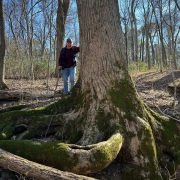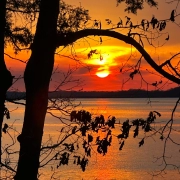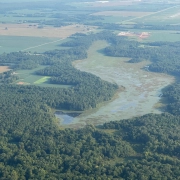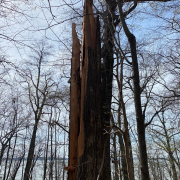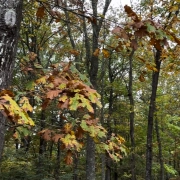Fungi and Other Discoveries along the Hickory Cove Nature Preserve’s Legacy Loop Trail
July 30, 2024, my two Alabama grandsons accompanied me on my first visit to the Land Trust of North Alabama’s Hickory Cove Nature Preserve northeast of Huntsville. We sauntered along the 1.75-mile Legacy Loop. I set the slow pace making observations and snapping photographs of mushrooms and other interesting features along the trail. They alternately surged ahead and fell behind, mostly the former.
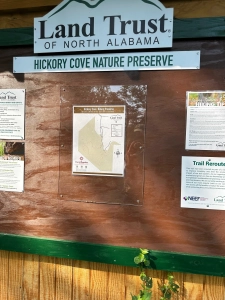
Every north Alabama trail is rich with human history. Native Americans occupied these lands for 13 millennia, leaving few obvious traces. European settlers left their mark more visibly and indelibly. A few hundred feet into the forest, a side trail directed us to the spring house, a sure indication of prior domestication, and a clear suggestion that Hickory Cove is not wilderness by the untrammled by the hand of man definition. Wildness, certainly; wilderness, no.
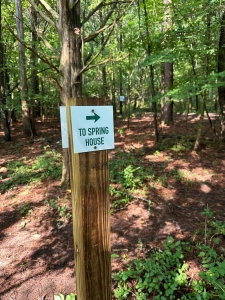
Sam stands at the old spring house foundation, likely an early 19th Century refrigeration construct for surviving here in the deep south prior to electricity and modern food preservation. The concrete trough (right) sits 100 feet downhill, still at brimful. I wondered whether our Native antecedents tapped this natural water source.
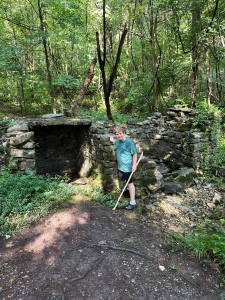
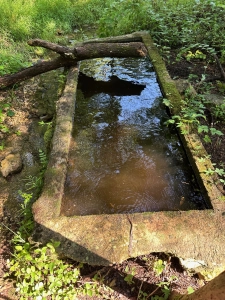
Trailside Fungi
I repeat often my observation that death is an essential facet of life in the forest. Sometimes an agent of tree death and always a primary decomposer, fungi are ubiquitous in our north Alabama forests. Usually invisible inside wood, among ground-level organic matter, and within forest soils, fungi hyphae are active year-round. They periodically manifest as mushrooms, their reproductive organs, spewing billions of spores to generate new colonies. A curry bolete drew our attention, its red cap waving a banner.
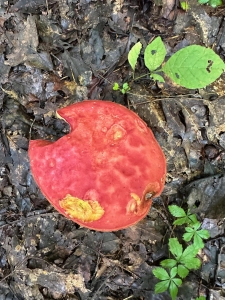
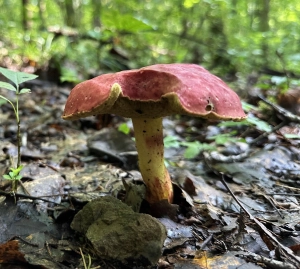
Most boletes are mycorhizal, sprouting from hyphae within the soil adjacent to roots (ectomycorrhizae) or alternatively within tree roots (endomycorrhizae), often symbiotically engaged with fine roots and root hairs of trees. This group of fungi includes neither pathogens or decomposers.
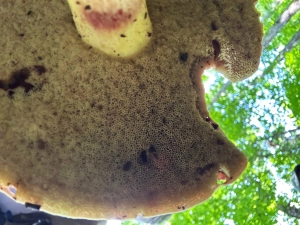
We also identified violet-grey boletes.
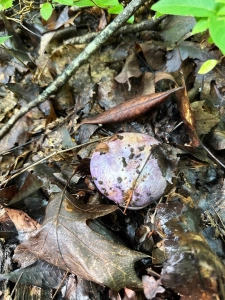
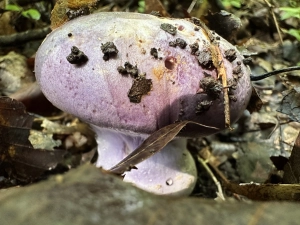
Six inches across, wood mushrooms demanded that we stop to examine and photograph.
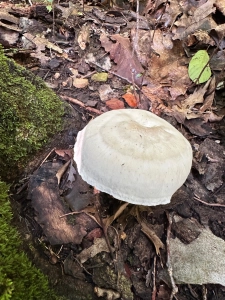
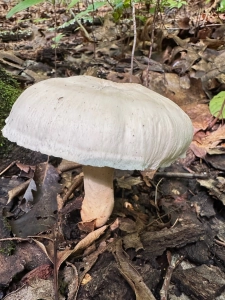
Pale yellow Amanita had begun to fade and break apart; even decomposing fungi produce mushrooms subject, as are all organisms, to biological breakdown. It’s the common tale of ashes to ashes, dust to dust.
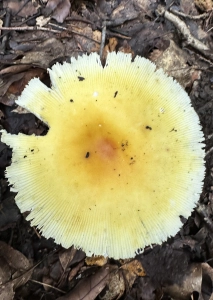
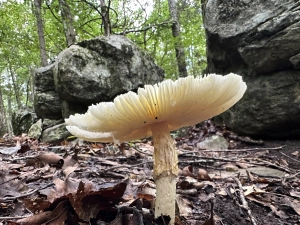
Examining the photo above right, I spotted a rock-critter lurking behind the Amanita. What is this woodland denizen? I asked my immediate family. They saw a bear, dog, bighorn sheep, and turtle. Such it is with clouds, forest limestone rocks, and oddly shaped trees!
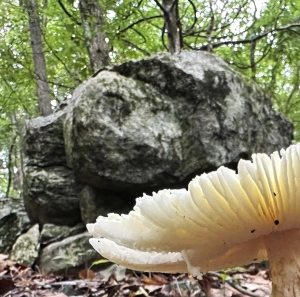
I’m reminded once again of Albert Einstein’s delightful fascination with imagination:
Imagination is more important than knowledge. For knowledge is limited to all we now know and understand, while imagination embraces the entire world, and all there ever will be to know and understand.
Fairy parachute mushrooms encircle the base of this dead cedar tree. An invasionary airborne fairy battalion dropped in the night prior, now huddled around the cedar awaiting a call to action.
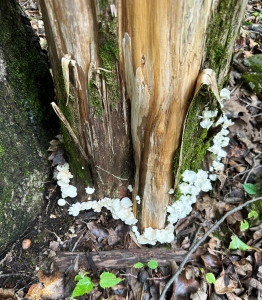
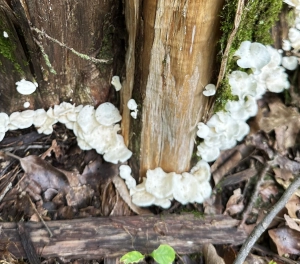
My iNaturalist hesitantly identified these as turkey tail mushrooms (Trametes versicolor), also listing several species from the Stereum genus as possibilities. Rather than declare turkey tail, I will go with genus Stereum. This colony appears to be thriving on a recently fallen red oak.
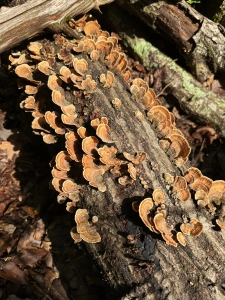
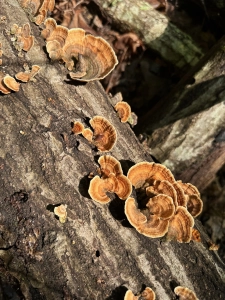
Toothed crust mushrooms coat this mature hickory. A single deer mushroom stands at the edge. Tree moss clings to the trunk at the far left margin. I recall hiking within the rain forests of southeat Alaska, where nary a forest surface is absent some kind growth. We do not qualify as rain forest, albeit 55 inches annually is a lot of rain.
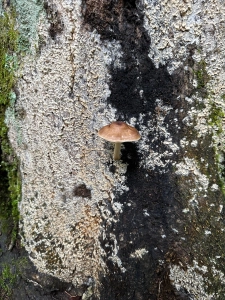
A closer look at the crust mushroom corroborates its moniker.
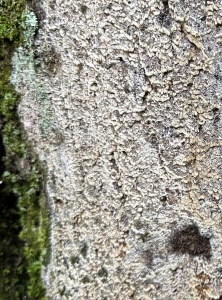
We found Trametes cubensis growing among tree moss on the deeply furrowed bark of a chestnut oak.
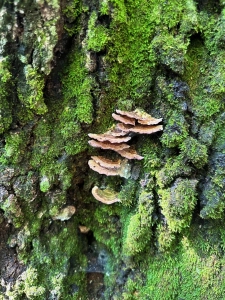
An edible mushroon, white-pored chicken of the woods visually decried its presence near the trail. The Land Trust prohibits collecting anything on its preserves. The boys and I made our observations, snapped a photograph, and left the mushroom behind.
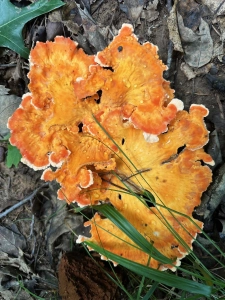
Many of our native vines (muscadine, scuppernog, Virgina creeper, and poison ivy) ascend into the upper canopy by attaching their air roots to rising tree stems and branches. Supplejack instead climbs by spiraling with companion vines or woody branches of trees and shrubs. I love the weakly striped perennially green stems.
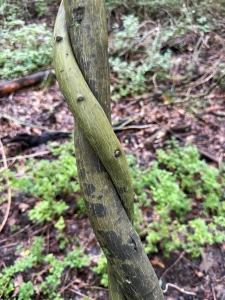
Sam found two whitelips snails flourishing along the trail. We stopped to examine them. They continued along their merry way, at what we assessed as faster than a snail’s pace!
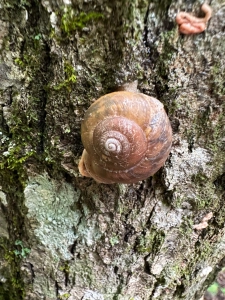
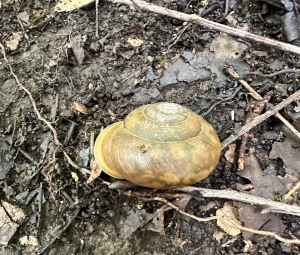
Many trees in our second (or third) growth forests are survivors from the prior generation. Imagine a prior landowner harvesting firewood, fenceposts, pulpwood, and scattered sawlogs around the time of the Second World War. The operation did not remove every tree, leaving hollow snags such as this red oak. It survived until this spring when its thin wood rind could no longer resist the forces of wind and gravity. Sam stands at left beside the hollow shell stump, which half-houses the accumulation of composted organic matter collected over a century or more. Just across the trail, Sam poses at the tree’s top where it leans almost vertically against another tree.
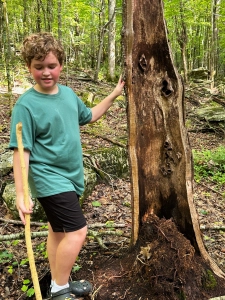
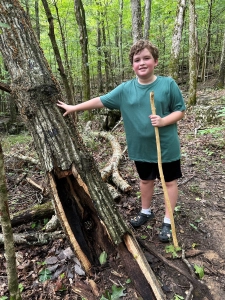
I took delight when Sam discovered the carcas and understood its story. I recorded this 58-second video at the scene. I’ve observed previously in these photo essays that a picture is worth a thousand words, and a brief video is priceless!
Nearly every north Alabama forest I explore dates its origins back 80-90 years. This 12-inch diameter green ash fell across the trail this summer. Crews made a clean chainsaw cut to remove it. Ash rings are very easy to discern and count. This cross-section, just a foot or two above the root collar, reads 86 years!
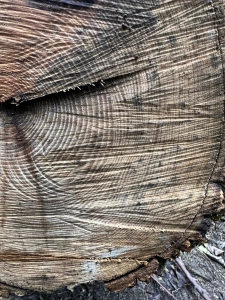
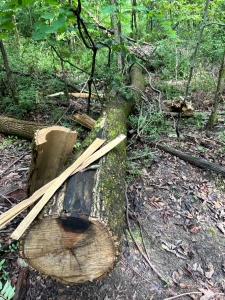
There are many stories revealed by a walk through the woods with grandsons. Knowing that Pap was scheduled for knee replacement surgery on August 20, the boys tried to stay within sight. My right knee hobbled me, subjecting me to unsteadiness and an inability to recover when and if I stumbled. About halfway, I did lose my balance and go down…it seemed to happen in slow motion. I’ve been stumbling in the woods for 70 years. I was unruffled; they were concerned. It seems just a few turns of the years that I was introducing their Mom (daughter Katy) to woodland wanders, then a few years when I carried these young men as babes when hiking, and now it is they who helped me back on my feet and offered assistence when the footing looked tenuous.
Einstein’s wisdom extended far beyond theoretical physics. Relative to my musings on my relationship to chldren and grandchildren, he observed:
Our death is not an end if we can live on in our children and the younger generation. For they are us; our bodies are only wilted leaves on the tree of life.
Thoughts and Reflections
I offer these observations:
- Imagination is more important than knowledge. For knowledge is limited to all we now know and understand, while imagination embraces the entire world, and all there ever will be to know and understand. (Albert Einstein)
- Our death is not an end if we can live on in our children and the younger generation. For they are us; our bodies are only wilted leaves on the tree of life. (Albert Einstein)
- Death and decomposition are a big part of life in the forest.
Inhale and absorb Nature’s elixir. May Nature Inspire, Inform, and Reward you!
Note: Unless otherwise noted, all blog post images are created & photographed by Stephen B. Jones. Please circulate images with photo credit: “©2024 Steve Jones, Great Blue Heron LLC. All Rights Reserved.”
And Third: I am available for Nature-Inspired Speaking, Writing, and Consulting — contact me at steve.jones.0524@gmail.com
A reminder of my Personal and Professional Purpose, Passion, and Cause
If only more of us viewed our precious environment through the filters I employ. If only my mission and vision could be multiplied by untold orders of magnitude:
Mission: Employ writing and speaking to educate, inspire, and enable readers and listeners to understand, appreciate, and enjoy Nature… and accept and practice Earth Stewardship.
Vision:
- People of all ages will pay greater attention to and engage more regularly with Nature… and will accept and practice informed and responsible Earth Stewardship.
- They will see their relationship to our natural world with new eyes… and understand their Earth home more clearly.
Tagline/Motto: Steve (Great Blue Heron) encourages and seeks a better tomorrow through Nature-Inspired Living!
Steve’s Four Books
I wrote my books Nature Based Leadership (2016), Nature-Inspired Learning and Leading (2017), Weaned Seals and Snowy Summits: Stories of Passion for Place and Everyday Nature (2019; co-authored with Dr. Jennifer Wilhoit), and Dutton Land & Cattle: A Land Legacy Story (2023) to encourage all citizens to recognize and appreciate that every lesson for living, learning, serving, and leading is either written indelibly in or is powerfully inspired by Nature. All four of my books present compilations of personal experiences expressing my deep passion for Nature. All four books offer observations and reflections on my relationship with the natural world… and the broader implications for society. Order any from your local indie bookstore, or find them on IndieBound or other online sources such as Amazon and LifeRich.
I began writing books and Posts for several reasons:
- I love hiking and exploring Nature
- I see images I want to (and do) capture with my trusty iPhone camera
- I enjoy explaining those images — an educator at heart
- I don’t play golf!
- I do love writing — it’s the hobby I never needed when my career consumed me
- Judy suggested my writing is in large measure my legacy to our two kids, our five grandkids, and all the unborn generations beyond
- And finally, perhaps my books and Blogs could reach beyond family and touch a few other lives… sow some seeds for the future
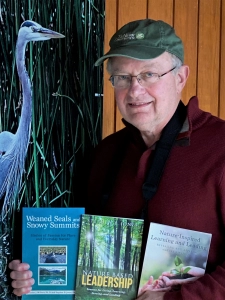
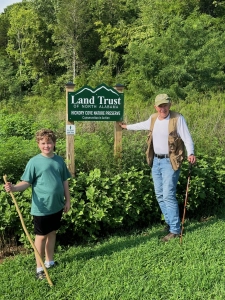
Steve’s Four Books
I wrote my books Nature Based Leadership (2016), Nature-Inspired Learning and Leading (2017), Weaned Seals and Snowy Summits: Stories of Passion for Place and Everyday Nature (2019; co-authored with Dr. Jennifer Wilhoit), and Dutton Land & Cattle: A Land Legacy Story (2023) to encourage all citizens to recognize and appreciate that every lesson for living, learning, serving, and leading is either written indelibly in or is powerfully inspired by Nature. All four of my books present compilations of personal experiences expressing my deep passion for Nature. All four books offer observations and reflections on my relationship with the natural world… and the broader implications for society. Order any from your local indie bookstore, or find them on IndieBound or other online sources such as Amazon and LifeRich.

